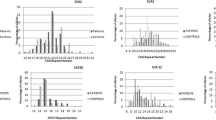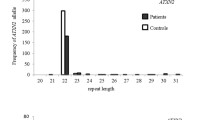Abstract
It has recently been suggested that short expansions of CAG repeat in the gene ATXN-2 causing SCA2 (spinocerebellar ataxia type 2) are associated with an increased risk of amyotrophic lateral sclerosis (ALS) in the populations of the USA and northern Europe. In this study, we investigated the role of ATXN-2 in Italian patients clinically diagnosed with ALS and characterized the molecular structure of ATXN-2 expansions. We assessed the size of the CAG repeat in ATXN-2 exon 1 in 232 Italian ALS patients and 395 matched controls. ATXN-2 expanded alleles containing >30 repeats have been observed in seven sporadic ALS patients (3.0%), while being absent in the controls (p = 0.00089). Four out of the seven patients had an ATXN-2 allele in the intermediate-fully pathological range: one with 32 repeats, 2 with 33 repeats and 1 with 37 repeats, accounting for 1.7% of the ALS cohort. Sequencing of expanded (>32) alleles showed that they were all interrupted with at least one CAA triplet. ATXN-2 alleles with the same length and structure have been reported in SCA2 patients with parkinsonism or in familial and sporadic Parkinson. Conversely, the phenotype of the present patients was typically ALS with no signs or symptoms of ataxia or parkinsonism. In conclusion, the findings of ATXN-2 expansions in pure ALS cases suggest that ALS may be a third phenotype (alongside ataxia/parkinsonism and pure Parkinson) associated with ATXN-2 interrupted alleles.

Similar content being viewed by others
References
Brooks BR, Miller RG, Swash M, Munsat TL, World Federation of Neurology Research Group on Motor Neuron Diseases (2000) El Escorial revisited: revised criteria for the diagnosis of amyotrophic lateral sclerosis. Amyotroph Lateral Scler Other Motor Neuron Disord 1:293–299
Byrne S, Walsh C, Lynch C, Bede P, Elamin M, Kenna K, McLaughlin R, Hardiman O (2010) Rate of familial amyotrophic lateral sclerosis: a systematic review and meta-analysis. J Neurol Neurosurg Psychiatry. doi:10.1136/jnnp.2010.224501
Cancel G, Dürr A, Didierjean O, Imbert G, Bürk K, Lezin A, Belal S, Benomar A, Abada-Bendib M, Vial C, Guimarães J, Chneiweiss H, Stevanin G, Yvert G, Abbas N, Saudou F, Lebre AS, Yahyaoui M, Hentati F, Vernant JC, Klockgether T, Mandel JL, Agid Y, Brice A (1997) Molecular and clinical correlations in spinocerebellar ataxia 2: a study of 32 families. Hum Mol Genet 6:709–715
Charles P, Camuzat A, Benammar N, Sellal F, Destée A, Bonnet AM, Lesage S, Le Ber I, Stevanin G, Dürr A, Brice A et al (2007) French Parkinson’s Disease Genetic Study Group. Are interrupted SCA2 CAG repeat expansions responsible for parkinsonism? Neurology 69:1970–1975
Costanzi-Porrini S, Tessarolo D, Abbruzzese C, Liguori M, Ashizawa T, Giacanelli M (2000) An interrupted 34-CAG repeat SCA-2 allele in patients with sporadic spinocerebellar ataxia. Neurology 54:491–493
Elden AC, Kim HJ, Hart MP, Chen-Plotkin AS, Johnson BS, Fang X, Armakola M, Geser F, Greene R, Lu MM, Padmanabhan A, Clay-Falcone D, McCluskey L, Elman L, Juhr D, Gruber PJ, Rüb U, Auburger G, Trojanowski JQ, Lee VM, Van Deerlin VM, Bonini NM, Gitler AD (2010) Ataxin-2 intermediate-length polyglutamine expansions are associated with increased risk for ALS. Nature 466:1069–1075
Furtado S, Payami H, Lockhart PJ, Hanson M, Nutt JG, Singleton AA, Singleton A, Bower J, Utti RJ, Bird TD, de la Fuente-Fernandez R, Tsuboi Y, Klimek ML, Suchowersky O, Hardy J, Calne DB, Wszolek ZK, Farrer M, Gwinn-Hardy K, Stoessl AJ (2004) Profile of families with parkinsonism-predominant spinocerebellar ataxia type 2 (SCA2). MovDisord 19:622–629
Gwinn-Hardy K, Chen JY, Liu HC, Liu TY, Boss M, Seltzer W, Adam A, Singleton A, Koroshetz W, Waters C, Hardy J, Farrer M (2000) Spinocerebellar ataxia type 2 with parkinsonism in ethnic Chinese. Neurology 55:800–805
Hussey J, Lockhart PJ, Seltzer W, Wszolek ZK, Payami H, Hanson M, Gwinn-Hardy K, Farrer M (2002) Accurate determination of ataxin-2 polyglutamine expansion in patients with intermediate-range repeats. Genet Test 6:217–220
Infante J, Berciano J, Volpini V, Corral J, Polo JM, Pascual J, Combarros O (2004) Spinocerebellar ataxia type 2 with levodopa-responsive parkinsonism culminating in motor neuron disease. MovDisord 19:848–852
Kim JM, Hong S, Kim GP, Choi YJ, Kim YK, Park SS, Kim SE, Jeon BS (2007) Importance of low-range CAG expansion and CAA interruption in SCA2 Parkinsonism. Arch Neurol 64:1510–1518
Lagier-Tourenne C, Polymenidou M, Cleveland DW (2010) TDP-43 and FUS/TLS: emerging roles in RNA processing and neurodegeneration. Hum Mol Genet 19:R46–R64
Lee T, Li YR, Ingre C, Weber M, Grehl T, Gredal O, de Carvalho M, Meyer T, Tysnes OB, Auburger G, Gispert S, Bonini NM, Andersen PM, Gitler AD (2011) Ataxin-2 intermediate-length polyglutamine expansions in European ALS patients. Hum Mol Genet 20:1697–1700
Lu CS, Wu Chou YH, Kuo PC, Chang HC, Weng YH (2004) The parkinsonian phenotype of spinocerebellar ataxia type 2. Arch Neurol 61:35–38
Nanetti L, Fancellu R, Tomasello C, Gellera C, Pareyson D, Mariotti C (2009) Rare association of motor neuron disease and spinocerebellar ataxia type 2 (SCA2): a new case and review of the literature. J Neurol 256:1926–1928
Payami H, Nutt J, Gancher S, Bird T, McNeal MG, Seltzer WK, Hussey J, Lockhart P, Gwinn-Hardy K, Singleton AA, Singleton AB, Hardy J, Farrer M (2003) SCA2 may present as levodopa-responsive parkinsonism. MovDisord 18:425–429
Shan DE, Liu RS, Sun CM, Lee SJ, Liao KK, Soong BW (2004) Presence of spinocerebellar ataxia type 2 gene mutation in a patient with apparently sporadic Parkinson’s disease: clinical implications. MovDisord 19:1357–1360
Silveira I, Miranda C, Guimarães L, Moreira MC, Alonso I, Mendonça P, Ferro A, Pinto-Basto J, Coelho J, Ferreirinha F, Poirier J, Parreira E, Vale J, Januário C, Barbot C, Tuna A, Barros J, Koide R, Tsuji S, Holmes SE, Margolis RL, Jardim L, Pandolfo M, Coutinho P, Sequeiros J (2002) Trinucleotide repeats in 202 families with ataxia: a small expanded (CAG)n allele at the SCA17 locus. Arch Neurol 59:623–629
Sobczak K, Krzyzosiak WJ (2005) CAG repeats containing CAA interruptions form branched hairpin structures in spinocerebellar ataxia type 2 transcripts. J BiolChem 280:3898–3910
Yu Z, Zhu Y, Chen-Plotkin AS, Clay-Falcone D, McCluskey L, Elman L, Kalb RG, Trojanowski JQ, Lee VM, Van Deerlin VM, Gitler AD, Bonini NM (2011) PolyQ repeat expansions in ATXN2 associated with ALS are CAA interrupted repeats. PLoS One 6:e17951
Acknowledgments
We thank the patients and their families for their participation. SD was financed by RegionePiemonte (Ricerca Sanitaria Finalizzata Project-Grant 2006/Grant 2008). LC by a fellowship from “Amico Canobio” Association. We thank Joe Haining for editing the manuscript.
Author information
Authors and Affiliations
Corresponding author
Additional information
A. Brusco and S. D’Alfonso are joint senior authors.
Rights and permissions
About this article
Cite this article
Corrado, L., Mazzini, L., Oggioni, G.D. et al. ATXN-2 CAG repeat expansions are interrupted in ALS patients. Hum Genet 130, 575–580 (2011). https://doi.org/10.1007/s00439-011-1000-2
Received:
Accepted:
Published:
Issue Date:
DOI: https://doi.org/10.1007/s00439-011-1000-2




